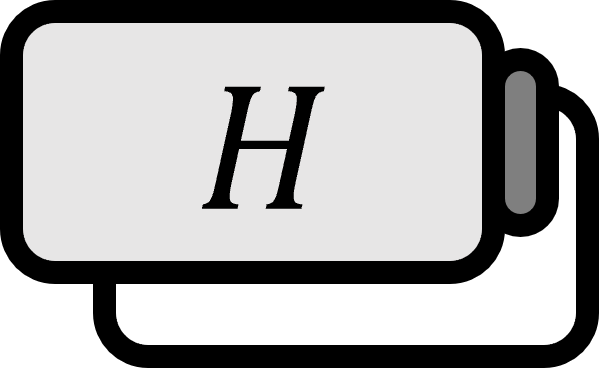리즈 표현 정리 증명
정리1
$\left( H, \left\langle \cdot,\cdot \right\rangle \right)$가 힐베르트 공간이라고 하자. $H$의 선형 범함수 $f \in H^{ \ast }$와 $\mathbf{x} \in H$ 에 대해 $f ( \mathbf{x} ) = \left\langle \mathbf{x} , \mathbf{w} \right\rangle$와 $\| f \|_{H^{\ast}} = \| \mathbf{w} \|_{H}$ 을 만족하는 $\mathbf{w} \in H$ 가 유일하게 존재한다.
설명
쉽게 말해 힐베르트 공간의 듀얼 스페이스 $H^{ \ast }$ 의 모든 원소가 어떻게 생겼는지 규명한 셈인데, 이게 말은 간단해도 함수라는 게 정의하는 사람 마음대로라는 걸 생각해보면 이런 정리를 증명할 생각을 한 것부터가 경이롭다고 할 수 있겠다.
증명
$f = 0$ 라고 하면 $f ( \cdot ) = \left\langle \cdot , \mathbf{0} \right\rangle$ 와 $\| f \| = 0$ 을 만족하는 $\mathbf{y} = \mathbf{0}$가 존재해서 증명할 게 없으므로 $f \ne 0$ 이라고 가정하자.
Part 1. 존재성
힐베르트 공간 $H$의 닫힌 부분공간 $W$ 에 대해
$$ H = W \oplus W^{\perp} $$
$W= \ker (f) = \left\{ \mathbf{x} \in H : f(\mathbf{x}) = 0 \right\}$이라고 하자. $\ker (f)$ 는 닫힌 부분공간이므로 직교분해정리에 의해
$$ H = W \oplus W^{\perp} $$
이고 $W^{\perp} \ne \left\{ \mathbf{0} \right\}$이다. 따라서 $\left\| \mathbf{y} \right\|=1$인 $\mathbf{y} \in W^{\perp}$를 하나 선택하자. $W^{\perp}$도 벡터공간이므로 $\mathbf{0}$이 아닌 원소가 하나라도 있으면 이러한 $\mathbf{y}$의 존재는 반드시 보장된다. 그리고 이제 임의의 $\mathbf{x} \in H$에 대해서, 다음과 같은 벡터 $\mathbf{z} \in H$를 생각하자.
$$ \mathbf{z} := f(\mathbf{x})\mathbf{y} - f(\mathbf{y})\mathbf{x} $$
여기서 $f(\mathbf{x}), f(\mathbf{y})$는 상수임에 주의하자. 이 $\mathbf{z}$에 선형범함수 $f$를 적용하면 선형성에 의해 다음을 얻는다.
$$ f(\mathbf{z}) = f\left( f(\mathbf{x})\mathbf{y} - f(\mathbf{y})\mathbf{x} \right) = f(\mathbf{x})f(\mathbf{y}) - f(\mathbf{y})f(\mathbf{x}) = 0 $$
따라서 $\mathbf{z} \in W$이다. 그러면 $\mathbf{y} \in W^{\perp}$라고 했으므로 둘의 내적은 $0$이다.
$$ \left\langle \mathbf{z}, \mathbf{y} \right\rangle = \left\langle f(\mathbf{x})\mathbf{y} - f(\mathbf{y})\mathbf{x}, \mathbf{y} \right\rangle = 0 $$
내적을 풀어내면 다음을 얻는다.
$$ f(\mathbf{x}) \left\langle \mathbf{y}, \mathbf{y} \right\rangle - f(\mathbf{y})\left\langle \mathbf{x}, \mathbf{y} \right\rangle = f(\mathbf{x}) \left\| \mathbf{y} \right\|^{2} - f(\mathbf{y})\left\langle \mathbf{x}, \mathbf{y} \right\rangle = f(\mathbf{x}) - f(\mathbf{y})\left\langle \mathbf{x}, \mathbf{y} \right\rangle=0 $$
$$ \implies f(\mathbf{x}) = f(\mathbf{y})\left\langle \mathbf{x}, \mathbf{y} \right\rangle = \left\langle \mathbf{x}, \overline{f(\mathbf{y})}\mathbf{y} \right\rangle $$
여기서 $\mathbf{w} = \overline{f(\mathbf{y})}\mathbf{y}$라고 하면 $f(\mathbf{x}) = \left\langle \mathbf{x} , \mathbf{w} \right\rangle$이다. 또한 코시-슈바르츠 부등식에 의해 $$ \| f \| = \sup_{ \| \mathbf{x} \| =1} | f(\mathbf{x}) | = \sup_{ \| \mathbf{x} \| =1} \left| \left\langle \mathbf{x} , \mathbf{w} \right\rangle \right| \le \sup_{ \| \mathbf{x} \| =1} \| \mathbf{x} \| \cdot \| \mathbf{w} \| = \| \mathbf{w} \| $$
이고, $\left\| \dfrac{\mathbf{w}}{\left\| \mathbf{w}\right\|} \right\|=1$ 이므로
$$ \| f \| = \sup_{ \| \mathbf{x} \| =1} | f(\mathbf{x}) | = \sup_{ \| \mathbf{x} \| =1} \left| \left\langle \mathbf{x} , \mathbf{w} \right\rangle \right| \ge \left\langle {{ \mathbf{w} } \over { \| \mathbf{w} \| }} , \mathbf{w} \right\rangle = {{ \| \mathbf{w} \|^2 } \over { \| \mathbf{w} \| }} = \| \mathbf{w} \| $$
가 성립하여 $\left\| f \right\| = \left\| \mathbf{w} \right\|$이다. 따라서 $\mathbf{w}$가 정리의 조건을 만족시킨다는 것을 알 수 있다.
Part 2. 유일성
이제 $\mathbf{w}^{\prime}$도
$$ f(\mathbf{x}) = \left\langle \mathbf{x}, \mathbf{w}^{\prime} \right\rangle $$
를 만족시킨다고 해보자.
$\left( H, \left\langle \cdot,\cdot \right\rangle \right)$를 힐베르트 공간이라고 하자. $x, y \in H$에 대해서 다음이 성립한다고 가정하자.
$$ \left\langle x, y \right\rangle = \left\langle x, z \right\rangle, \quad \forall x \in H $$
그러면 $y = z$이다.
그러면 위의 보조정리에 의해 이러한 $\mathbf{w}=\mathbf{w}^{\prime}$임을 알 수 있다.
■
Ole Christensen, Functions, Spaces, and Expansions: Mathematical Tools in Physics and Engineering (2010), p70-71 ↩︎

 저희들의 저서 「줄리아 프로그래밍」이 2024 세종도서 학술부문에 선정되었습니다!
저희들의 저서 「줄리아 프로그래밍」이 2024 세종도서 학술부문에 선정되었습니다!

